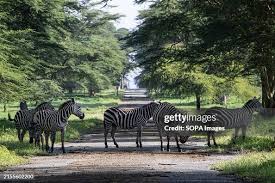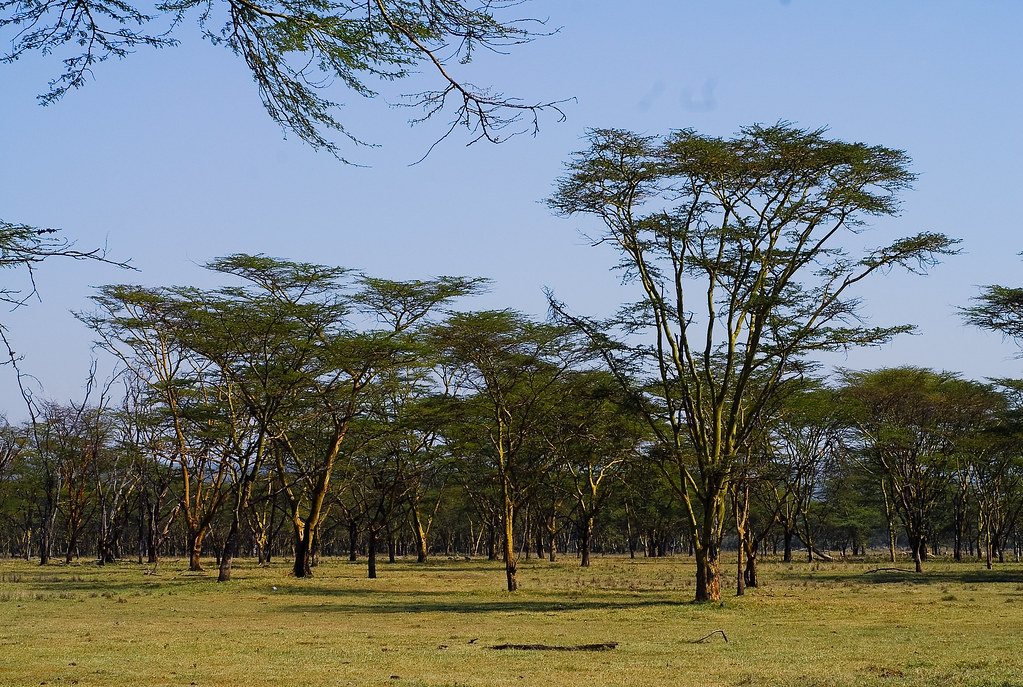Lake Nakuru National Park’s ecosystem is a rich tapestry of diverse habitats that support a wide range of wildlife species. Dominated by the alkaline Lake Nakuru, the park’s wetlands serve as a crucial habitat for aquatic life and are famously home to vast flocks of flamingos. Surrounding the lake, the park features savanna grasslands, thick acacia forests, rocky cliffs, and bushy woodlands, creating varied environments that sustain everything from herbivores like zebras and buffaloes to predators such as lions and leopards. These ecosystems play a vital role in supporting both resident and migratory species, making Lake Nakuru a key conservation site in Kenya.
This guide is partly based on detailed research, including the work of 1994 Joseph G. Mutangah Study , “The Vegetation of Lake Nakuru National Park, Kenya,” and offers a comprehensive look at the park’s key ecosystems and their ecological significance.
Here’s an expert guide on the key ecosystems within the park:
1. Acacia Woodlands
Acacia woodlands dominate large portions of the park, particularly around the lake and surrounding hills. These woodlands are primarily composed of Acacia xanthophloea (fever trees) and Acacia seyal, which thrive in areas with rich volcanic soils and moderate rainfall.

- Significance: Acacia trees provide essential habitats for many animals, including giraffes, which feed on their leaves, and baboons, which often forage in these areas.
- Ecological Role: The dense woodlands offer shade and shelter to wildlife, maintaining cooler microclimates within the park. They also play a role in soil stabilization, preventing erosion along the lake’s shoreline.
2. Grasslands
Open grasslands cover the low-lying areas around Lake Nakuru and are a crucial ecosystem for grazing herbivores such as zebras, buffaloes, and impalas. These grasslands, dominated by species such as Cynodon dactylon and Chloris gayana, thrive in the park’s fertile volcanic soils.
- Significance: The grasslands are vital for supporting large herbivore populations, which in turn sustain predators like lions and leopards.
- Ecological Role: Grasslands are key to the park’s grazing ecosystem, providing essential nutrition for herbivores. Regular grazing also promotes the growth of new plant shoots, ensuring the regeneration of grass species.
3. Lake Nakuru’s Alkaline Ecosystem
At the heart of the park lies Lake Nakuru, an alkaline soda lake that is central to its ecosystem. The lake’s alkalinity supports the growth of cyanobacteria (blue-green algae), which is a primary food source for the famous flamingos.
- Flamingos: Millions of lesser flamingos feed on the algae in the shallow waters of the lake, giving the lake its iconic pink hue.
- Significance: Besides flamingos, the lake supports other bird species, including pelicans and herons. The wetlands surrounding the lake provide habitats for amphibians and aquatic mammals like hippos.
4. Riverine Forests
Along the Njoro River and other streams that feed into Lake Nakuru, riverine forests can be found. These forests, characterized by species like Ficus sycomorus (sycamore fig) and Vachellia tortilis (umbrella thorn acacia), are home to a variety of wildlife.
- Significance: These lush forests provide shelter and food for animals like monkeys, bushbucks, and a range of bird species.
- Ecological Role: The riverine forests help regulate water flow into the lake, reducing the risk of flooding during heavy rains and maintaining water quality by filtering sediments.

5. Makalia Waterfall and Surrounding Bushland
The Makalia Waterfall, located in the southern part of the park, is surrounded by bushland and rocky terrain. The plant species here are adapted to the rocky soils and include hardy shrubs and grasses.
- Significance: This area is a haven for small mammals and reptiles, as well as some larger species such as buffaloes that seek refuge in the bushland.
- Ecological Role: The rocky terrain around the waterfall is crucial for controlling erosion and provides unique niches for plant species that thrive in drier, more exposed conditions.
6. Alkaline Marshes
The park’s alkaline marshes, located near the lake’s edge, are home to halophytic (salt-tolerant) plants such as Suaeda monoica and Sporobolus spicatus. These marshes serve as important breeding grounds for birds and support various invertebrate species.
- Significance: The marshes are crucial for the park’s bird population, providing nesting sites for species like the great white pelican.
- Ecological Role: These marshes filter pollutants and sediments from water runoff, helping to maintain the lake’s ecological balance.
7. Upland Evergreen Forests
On the higher slopes of the Bahati Hills, evergreen forests can be found. These forests, dominated by species like Juniperus procera (African pencil cedar) and Podocarpus latifolius (yellowwood), thrive in cooler and wetter conditions.
- Significance: These forests provide habitats for a different array of wildlife, including forest birds and small mammals.
- Ecological Role: They help in maintaining moisture in the atmosphere and act as carbon sinks, contributing to climate regulation within the park.
8. Anthropogenic Grasslands
Areas that were once heavily impacted by human activity, such as former farmland, have been reclaimed and restored as anthropogenic grasslands. These areas are slowly regenerating and are populated with a mix of native grasses and shrubs.
- Significance: These reclaimed grasslands are becoming important habitats for grazing animals, and their recovery is crucial for the park’s biodiversity.
- Ecological Role: The restored areas reduce soil erosion and contribute to the park’s overall ecological resilience.
Conservation and Threats
While Lake Nakuru National Park’s ecosystems are rich and diverse, they face significant threats from human encroachment, agricultural runoff, and climate change. These challenges can lead to habitat degradation, affecting both plant and animal species. Conservation efforts are critical to preserving these ecosystems, especially the management of water quality in Lake Nakuru, which directly impacts its iconic flamingo population.
The park’s unique ecological zones are a microcosm of Kenya’s diverse landscapes, and their preservation is essential for the continued success of the park as a haven for wildlife.
Conservation and Challenges:
- The park’s ecosystems face pressures from climate change, human encroachment, and fluctuating water levels that impact both aquatic and terrestrial habitats.
- Conservation efforts, such as the reforestation of acacia trees and the protection of rhinos, are crucial for maintaining ecosystem balance.
Conclusion:
Lake Nakuru National Park’s ecosystems are a microcosm of Kenya’s broader ecological diversity, from its alkaline lake and rich birdlife to its savanna grasslands and cliff ecosystems. The integration of these habitats makes it a crucial site for conservation and biodiversity. Visitors to the park can enjoy a rich array of wildlife and scenic landscapes while contributing to the ongoing efforts to protect this delicate environment.
